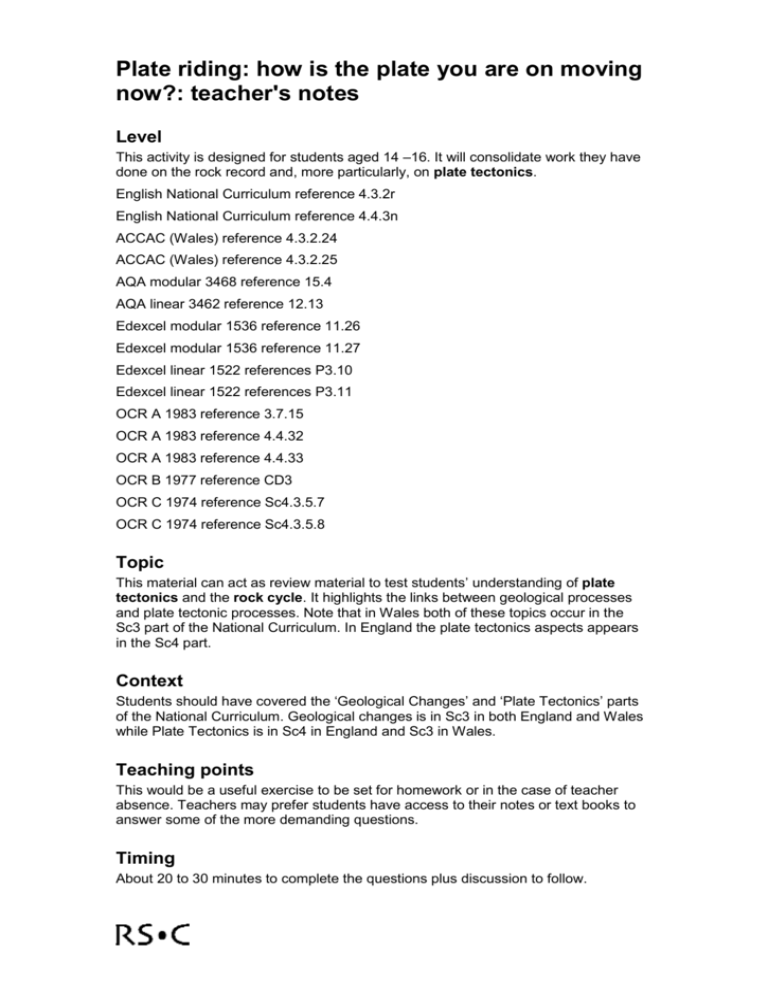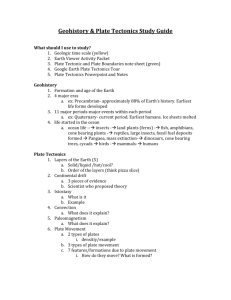Plate riding: how is the plate you are on moving now?: teacher`s notes
advertisement

Plate riding: how is the plate you are on moving now?: teacher's notes Level This activity is designed for students aged 14 –16. It will consolidate work they have done on the rock record and, more particularly, on plate tectonics. English National Curriculum reference 4.3.2r English National Curriculum reference 4.4.3n ACCAC (Wales) reference 4.3.2.24 ACCAC (Wales) reference 4.3.2.25 AQA modular 3468 reference 15.4 AQA linear 3462 reference 12.13 Edexcel modular 1536 reference 11.26 Edexcel modular 1536 reference 11.27 Edexcel linear 1522 references P3.10 Edexcel linear 1522 references P3.11 OCR A 1983 reference 3.7.15 OCR A 1983 reference 4.4.32 OCR A 1983 reference 4.4.33 OCR B 1977 reference CD3 OCR C 1974 reference Sc4.3.5.7 OCR C 1974 reference Sc4.3.5.8 Topic This material can act as review material to test students’ understanding of plate tectonics and the rock cycle. It highlights the links between geological processes and plate tectonic processes. Note that in Wales both of these topics occur in the Sc3 part of the National Curriculum. In England the plate tectonics aspects appears in the Sc4 part. Context Students should have covered the ‘Geological Changes’ and ‘Plate Tectonics’ parts of the National Curriculum. Geological changes is in Sc3 in both England and Wales while Plate Tectonics is in Sc4 in England and Sc3 in Wales. Teaching points This would be a useful exercise to be set for homework or in the case of teacher absence. Teachers may prefer students have access to their notes or text books to answer some of the more demanding questions. Timing About 20 to 30 minutes to complete the questions plus discussion to follow. Answers to questions Q 1. (a) It is moving towards the east. (b) 3 cm per year (about as fast as your fingernails grow) Q 2. Everything on the plate is also moving at the same speed. Also it is so slow that it would be impossible to detect. Q 3. Accept any answer for plate tectonics that students may have met (identical rocks or fossils on continents that are now split / ‘jigsaw fitting’ pattern of continents that were once joined / evidence from magnetic stripes on ocean floors). Q 4. Global Positioning Systems (GPSs) can make very accurate measurements of the Earth’s surface at intervals. They will fix a given point by latitude and longitude on the surface and the movement of a point with respect to this can then be measured. Q 5. No. While some move away from one another, others move towards one another and some slide past one another. Q 6. (a) The plates concerned must be moving away from one another. The Eurasian plate is moving away from the N. American plate, for example. Since there is no hole in the ocean bed appearing, any gaps must be filled by new plate material through igneous activity at the mid-Atlantic ridge. The pulling apart (tension) causes tensional faulting and sections of crust can slide down forming a rift valley. Not much sediment has accumulated since the oceanic plate is so new. Apart from a bit of baking of one igneous rock by a newer hot one, there is no metamorphic activity (there are no compressional pressures to cause wide scale (regional) metamorphism). . (b) The plates concerned must be moving towards one another. There must be a collision zone ahead. This is the Eurasian plate colliding with the Pacific plate (forming Japan). Collision causes earthquakes in Japan - compressional faulting. Due to the collision, one plate sinks (subducts) beneath the other – this plate partially melts and causes volcanic activity (of a dangerous, explosive kind). Over time the volcanic mountains are weathered and eroded producing sediment, the sediment forms sedimentary rocks. Plate pressure deforms the rocks into intense folds. Heat and pressure due to the collision cause metamorphism of the rocks. Q 7. Most igneous activity is at the margin behind and at the margin in front (there is no igneous activity in the middle of this plate). The activity behind is caused by magma rising at the mid-Atlantic ridge. Activity ahead is caused by frictional forces as one plate subducts below the other producing explosive volcanic activity. Q 8. In the collision zone. Where there are mountains being formed, these are readily attacked by weathering and erosion processes. This causes high rates of sedimentary activity. Q 9. In the collision zone. Heat and pressure due to the collision causes metamorphism of the rocks. Q 10. In the collision zone there can be intense folding, and faulting and dangerous earthquake activity. It is much quieter where plates are moving apart.







